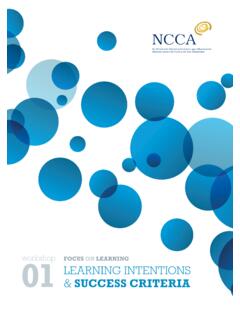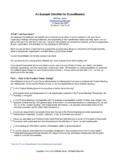Transcription of MISRA Compliance:2020
1 Permit / Example / C:2012 / Compliance:2020 Achieving compliance with MISRA Coding GuidelinesFebruary 2020 First published February 2020 by HORIBA MIRA LimitedWatling StreetNuneatonWarwickshireCV10 HORIBA MIRA Limited, 2020. MISRA , MISRA C and the triangle logo are registered trademarks owned by HORIBA MIRA Ltd, held on behalf of the MISRA Consortium. Other product or brand names are trademarks or registered trademarks of their respective holders and no endorsement or recommendation of these products by MISRA is implied. All rights reserved. No part of this publication may be reproduced, stored in a retrieval system or transmitted in any form or by any means, electronic, mechanical or photocopying, recording or otherwise without the prior written permission of the 978-1-906400-26-2 PDF British Library Cataloguing in Publication DataA catalogue record for this book is available from the British Library MISRA Compliance:2020 Achieving compliance with MISRA Coding GuidelinesFebruary 2020iMISRA Mission StatementWe provide world-leading, best practice guidelines for the safe and secure application of both embedded control systems and standalone is a collaboration between manufacturers, component suppliers and engineering consultancies which seeks to promote best practice in developing safety- and security-related electronic systems and other software-intensive applications.
2 To this end, MISRA publishes documents that provide accessible information for engineers and management, and holds events to permit the exchange of experiences between to the requirements of this document does not in itself ensure error-free robust software or guarantee portability and with the requirements of this document, or any other standard, does not of itself confer immunity from legal lot of work has taken place within the MISRA C and MISRA C++ Working Groups since the initial release of MISRA Compliance in 2016, with one of the outcomes being that all future releases of MISRA Guidelines will mandate the use of MISRA to this point, the MISRA Guideline documents have all included content related to the various MISRA compliance activities. This update to MISRA Compliance enhances Section (now titled Framework ) of Chapter 2 (now titled The software development process ), completing the definition of what must be covered within the software development process when making a claim of MISRA compliance.
3 This is mainly a house-keeping exercise, allowing the compliance-related content to be replaced by references to this document, ensuring consistency among the MISRA Guidelines whilst reducing the effort required in their TappChairman, MISRA C++ Working Group iiiAcknowledgementsThe MISRA consortium wishes to acknowledge the contribution made by the Japan Automobile Manufacturers Association to the preparation of this MISRA consortium would like to thank the following individuals for their significant contribution to the writing of this document:Paul BurdenIndependent Consultant (Formerly Programming Research Ltd)Chris TappLDRA Ltd / Keylevel Consultants LtdThe MISRA consortium also wishes to acknowledge contributions from the following members of the MISRA C Working Group during the development and review process:Andrew BanksLDRA Ltd / Intuitive ConsultingLiz WhitingLDRA LtdThe MISRA consortium also wishes to acknowledge contributions from the following individuals during the development and review process.
4 David WardHORIBA MIRA LtdivContents1 Introduction12 The software development The development Style Tool Selecting the Selecting static analysis Tool Understanding and configuring the Understanding and configuring the static analysis Run-time behaviour73 Fundamental elements of Guideline Analysis The guideline enforcement Investigating Decidability104 The role of Deviation Deviation Justifying a deviation135 The guideline re-categorization Re-categorization156 Adopted The nature of adopted System wide analysis Adopted binary Adopted source Adopted header The Standard Library197 Claiming MISRA Staff The management The guideline compliance Project delivery228 References24 Appendix A Process and tools checklist25 Appendix B Example deviation record26 Appendix C Example deviation permit29 Appendix D Glossary30vi1 IntroductionThe MISRA language documents [1] and [2] ( The Guidelines ) are compilations of guidelines for coding in the C [3] and C++ [4] languages.
5 They are widely used in the development of critical software systems when the requirements of a quality standard must be met. Many software projects specify that code quality should be assured by meeting the requirements of The Guidelines. However, the meaning of the phrase MISRA compliant needs to be carefully order for a claim of MISRA compliance to have meaning, it is necessary to establish: Use of a disciplined software development process; Exactly which guidelines are being applied; The effectiveness of the enforcement methods; The extent of any deviations from the guidelines; The status of any software components developed outside of the Guidelines recognize that, in some situations, it is unreasonable or even impossible to comply with a coding guideline and that it is necessary to deviate from its requirements. The freedom to deviate does not necessarily compromise claims of compliance, but it does carry with it great responsibility.
6 In the absence of a disciplined development process, it is easy for that freedom to be abused. At best, that will undermine the credibility of any claims of MISRA compliance; at worst, it will compromise code quality, safety or security. It is therefore important to emphasize that a credible claim of compliance with The Guidelines can only be made when code is developed under a process which meets the principles laid out in this guidance given in this document supersedes the compliance, deviation and process requirements published previously in the various MISRA : The various MISRA Guideline documents have been refined and revised over a number of years. This document uses examples and extracts from a number of them, but the issues discussed are equally relevant to all of The software development development contractA decision to adopt and apply MISRA Guidelines should be taken at the outset of a project.
7 The application of MISRA Guidelines will typically be one requirement among many of a contractual agreement between two parties, the organization commissioning the project (the acquirer) and the organization developing the code (the supplier). These parties may be different commercial entities or they may simply be different departments within the same organization. Both will need to be actively involved in the task of assuring compliance with MISRA Guidelines. MISRA Compliance is not a rigidly defined concept and acceptance criteria will be a matter for negotiation. However there are some clear principles which must be observed in order for the concept of compliance to have Guidelines are intended to be used within the framework of a documented software development process. They are of greatest benefit when a process is in place to ensure that, for software requirements, including any safety or security requirements, are complete, unambiguous and correct; design specifications reaching the coding phase are correct, consistent with the requirements and do not contain any other functionality; object modules produced by the compiler behave as specified in the corresponding designs; object modules have been tested, individually and together, to identify and eliminate with MISRA Guidelines must be an integral component of the code development phase and compliance requirements need to be satisfied before code is submitted for review or unit testing.
8 A project that attempts to check for compliance late in its lifecycle is likely to spend a considerable amount of time in re-coding, re-reviewing and re-testing, and it is easy for this rework to introduce defects by accident. code shall be checked for compliance as it is developed and not as part of a tick-box exercise to be completed as part of the final delivery a project is building on code that already has a proven track record, then the benefits of gaining compliance by re-factoring existing code may be outweighed by the risks of introducing a defect. In such cases a judgement needs to be made based on the net benefit likely to be this document does not define a complete software development process, there are some process activities that must be included in order to demonstrate the adoption of best practice when claiming MISRA compliance: Training; Style guide; Metrics; Tool management; Run-time decisions made on these issues, including the reasons for those decisions, need to be documented, and appropriate records should be kept for any activities performed.
9 Such documentation may then be included in a safety justification, if required. Appendix A provides a checklist which may be helpful in ensuring that documentation is produced for these full discussion of the requirements for software development processes is outside the scope of this document. Further information may be found in standards such as ISO/IEC/IEEE 12207 [5], IEC 61508 [6], ISO 26262 [7], EN 50128 [8], IEC 62304 [9] and DO-178 [10]. order to ensure an appropriate level of skill and competence on the part of those who produce the source code , formal training should be provided for: The use of the chosen programming language for embedded applications; The use of the chosen programming language for high-integrity, safety-related or security-related compilers and static analysis tools are complex pieces of software, consideration should also be given to providing training in their use.
10 In the case of static analysis tools, it might be possible to obtain training in their use specifically in relation to the enforcement of MISRA guideAn organization should enforce an in-house style guide to provide guidance on issues that do not directly affect the correctness of the code , but rather define a house style for the appearance of the source code . These issues are subjective and typically include: code layout and use of indenting; Layout of braces { } and block structures; Naming conventions; Use of comments; Inclusion of company name, copyright notice and other standard file header of the style guide requirements is outside the scope of this [14] for further information on style use of metrics is recommended by many software process standards as a means to identify code that may require additional review and testing effort; they can be used to prevent unwieldy and un-testable code from being written by looking for values outside of established norms.






